Banque De L'Indochine |
| Banque de l'Indochine was a note-issuing bank established in Paris on 21 January 1875, for the territories of France in Asia. Up to World War II, the bank experienced three phases of development. From 1875 to 1888, it functioned as a colonial bank to help the French government manage its colonial properties in Southeast Asia. Then from 1889 to 1900, the bank shifted its operations from Indochina to China. Thereafter, from 1900 to 1941, the bank represented the interests of the French government in handling the Boxer indemnity and transacted international trade between France and China. |
1932-1939 ND Issue |
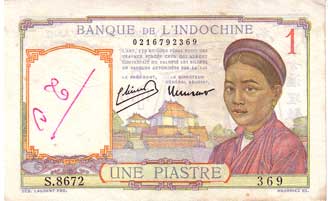 | P54d - 1 Piastre, 1949
Front: Woman at right, building at center, red denomination numeral 1
Back: Man with baskets at left, Chinese, Lao and Vietnamese text
Watermark: Side portrait of Mecury
Size: 128 x 80 mm |
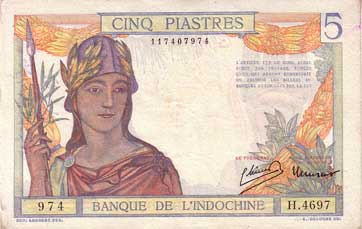 | P55c - 5 Piastre, 1946
Front: Woman with helmet and lance to left, large denomination numeral 5 over wreath at upper right on white backgroud
Back: Omen with headdress at left, ancient statues at right, Lao text
Watermark: Side portrait of Mecury
Size: 141 x 90 mm |
|
1942-1945 ND Issue |
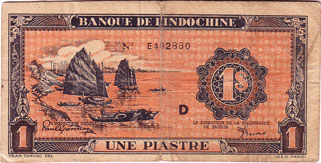 | P58 - 1 Piastre
Sampans at left
Back: Figure with hands together
Printer: I.D.E.O Hanoi - Imprimerie de l'Extreme Orient in Hanoi
Size: 125 x 62 mm |
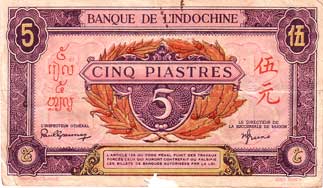 | P64 - 5 Piastre
Back: Pavillion at water's edge
Printer: I.D.E.O Hanoi - Imprimerie de l'Extreme Orient in Hanoi
Size: 126 x 73 mm |
|
1942-1945 ND Second Issue |
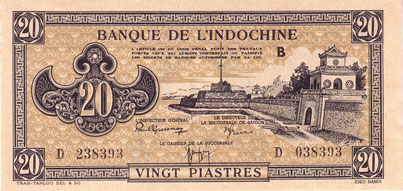 | P71 - 20 Piastres
Front: Walled fort
Back: Seated figure
Printer: I.D.E.O Hanoi - Imprimerie de l'Extreme Orient in Hanoi
Size: 157 x 75 mm |
|
1949; 1951 ND Issue |
| Printed in Japan in 1944. |
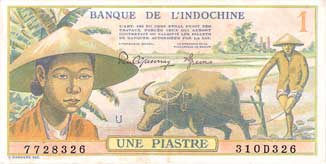 | P74 - 20 Piastre, 1949
Front: Two farmers with ox
Back: Two women with tree branches
Size: 127 x 63 mm |
|
1945 ND Issue |
| Printed in the US and England after WWII. |
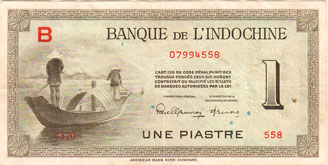 | P76a - 1 Piastre, 1951
Front: Two men in a boat, red letter "B" (possibly not issued), blue planchets
Back: Angkor Wat, blue planchets
Printer: American Bank Note Company
Size: 128 x 64 mm |
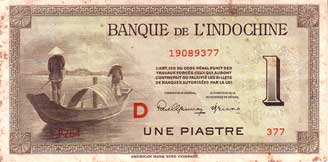 | P76b - 1 Piastre, 1951
Front: Two men in a boat, red letter "D"
Back: Angkor Wat, blue planchets
Printer: American Bank Note Company
Size: 128 x 64 mm |
|
1947-1951 ND Issue |
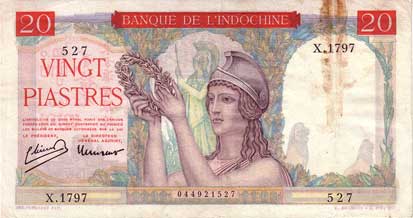 | P81 - 20 Piastre, 1949
Front: Helmeted woman holding wreath at center, Athens standing in background
Back: Helmeted woman holding wreath
Watermark: Frontal portrait of Mecury
Size: 161 x 85 mm |
|
1947-1951 ND Issue |
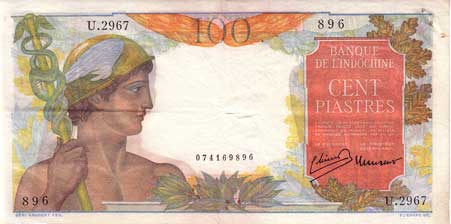 | P82 - 100 Piastre, 1949
Front: Mecury at left
Back: Elephant handler with two elephants at left, elephant handler with stick at right
Watermark: Side portrait of man with a hat
Size: 176 x 88 mm |
|
Government General De L'Indochine |
| When World War II broke out in Europe, the communication between France and Indochina became difficult and completely interrupted in 1940. When the German troops occupied Paris, the Japanese spreaded out into Viet Nam via China, but still placed Indochina under the authority of French Governor Decoux, being dependent on French Petain administration who took the side of Germans. During this time, the Indochina administration issued a new paper note with inscription GOUVERNEMENT GENERAL DE L'INDOCHINE (Government General of Indochina) by contracting with IDEO (Imprimerie d'Extreme-Orient) printing office in Hanoi. Due to the war and the lack of communication with France, the scarcity of ink and material for fine paper printing poor quality paper notes were produced.
The Japanese administration did not issue the occupation money in Indochina as they did in Philippine, China, and Malaya. However, in areas under their influence, the Japanese distributed a number of Japanese currency. The 50 sen, 1 yen, 5 yen, 10 yen, and 100 yen paper notes were similar to the notes issued by the Japanese in China, but in different color plus two letters RO and the Chinese inscription GOVERNMENT OF GREAT EMPIRE OF JAPAN. Those rare paper notes are of high value in the numismatist's market. |
1939 ND Issue |
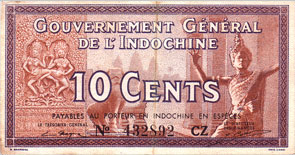 | P85d - 10 Cents
Front: Sculptures and left, dancers at right
Back: Elephants walking through a market
Size: 105 x 55 mm |
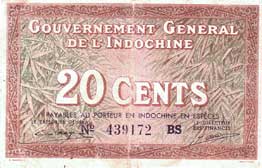 | P86d - 20 Cents
Front: Bamboo plants at left and right
Back: Girl with hat at left, boat at center
Size: 102 x 61 mm |
|
1942 ND Issue |
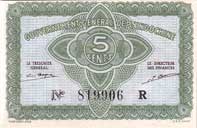 | P88 - 5 cents
Front: Denomination at center, signatures at left and right
Back: Forgery penalty clause at center
Size: 77 x 50 mm |
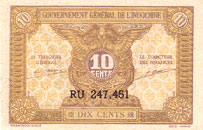 | P89a - 10 cents
Front: Denomination at center, signatures at left and right
Back: Forgery penalty clause at center
Size: 77 x 50 mm |
|
Institut D'Emission Des Etats Du Cambodge, Du Laos Et Du Vietnam |
|
At the end of World War II, the French came back to Indochina. By confronting the movement, Independence for Viet Nam, the French applied a policy of more tolerant rule, but still followed the general Lyautey's policy of "divide to easy control and exert power". The Franco-Vietnamese war raged and exhausted French's potentialities which were already declined after the world war. The Auriol-Bao Dai Agreement resulted — The French recognized the independence and unification of Viet Nam, but Viet Nam should join the French Union. On 31 December 1951, the paper money issuance power was transferred to Institute of Issuance (commonly known as Institute of Issuance of Cambodia, Laos, and Viet Nam). However, Indochina Bank continued to publish Indochina paper notes until the Institute of Issuance was capable of producing the required amount for Indochina.
The paper notes used in Viet Nam, Cambodia, Laos, and within the French Union had same characteristics. On front is the inscription INSTITUT D'EMISSION DES ETATS DU CAMBODGE, DU LAOS, ET DU VIETNAM and the value of the notes in French. On back is a symbol of each nation, INSTUTION OF ISSUANCE inscription and the value in Vietnamese, Cambodian, and Laotian. The highest value paper note in Indochina was 1000 piastre. The design was a sample and has never been issued. In 1954-1956, due to shortage in small changes, 1 piastre notes were torn into two to replace 50 cents; when assembled together, the note had the value of its sum. |
Viet Nam Issue |
1953-1954 ND Issue |
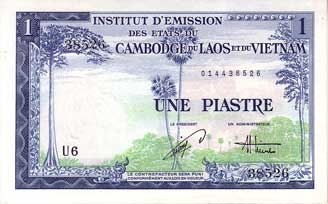 | P105 - 1 Piastre
Front: Trees
Back: Dragon at left
Watermark: Tiger head
Size: 128 x 79 mm |
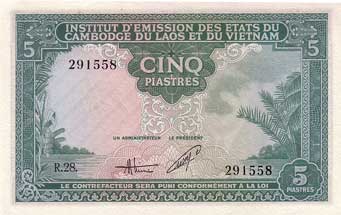 | P106 - 5 Piastre
Front: Banana trees at left, palm trees at right
Back: Bao Dai at left
Watermark: Tiger head
Size: 132 x 84 mm |
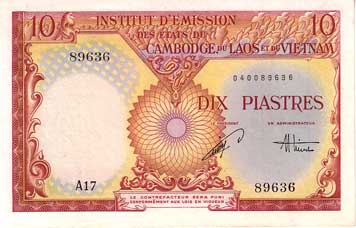 | P107 - 10 Piastre, 1953
Front: Stylized sunburst at center
Back: Rock in the Bay of Along at left, Vietnamese title at top
Watermark: Tiger head
Size: 139 x 88 mm |
 French Indo-China Paper Money Collection
French Indo-China Paper Money Collection French Indo-China Paper Money Collection
French Indo-China Paper Money Collection